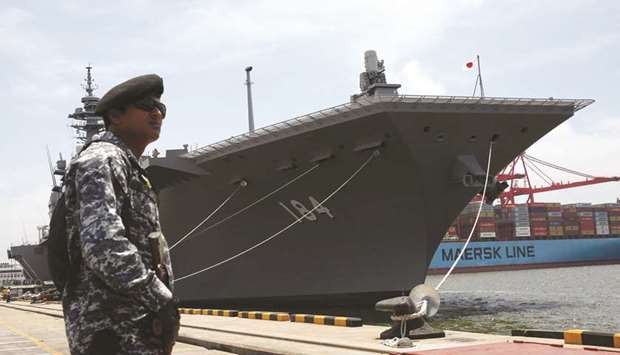Japan’s largest warship, the Kaga helicopter carrier, sailed into Sri Lanka’s Colombo harbour this weekend, marking Tokyo’s highest profile salvo in a diplomatic battle with China for influence along the region’s vital commercial sea lanes.
Japan has long provided low-interest loans and aid to Sri Lanka, helping it transform Colombo into a major trans-shipment port tapping the artery of global trade just south of the island that links Europe and the Middle East with Asia.
Japan’s military diplomacy is flourishing under Prime
Minister Shinzo Abe.
“Japan’s government is promoting a free and open Indo-Pacific and this deployment in the Asia Pacific is a component of that strategy,” Rear Admiral Tatsuya Fukuda, the commander of the Kaga and its destroyer escort, said in his cabin as the carrier steamed for Colombo through the Indian Ocean.
“Maritime security and stability is of critical importance” to an island nation like Japan, he added.
On its way to Sri Lanka, the 248m (814ft) ship carried out naval drills in the Philippines and Indonesia. It also drilled with a British Navy frigate before docking in Colombo on Sunday with 500 sailors and four submarine hunting helicopters aboard.
As part of the goodwill visit, the Kaga’s crew also brought packets of colourful origami paper, crafting flowers for local children who came to tour the ship soon after it docked.
The visit was intended to reassure Sri Lanka of Japan’s willingness and capability to dispatch its most powerful military assets to a region.
“Sri Lanka, as a hub in the Indian Ocean, and upholding its commitment to a free and open Indian Ocean, welcomes naval vessels from all our partner nations, to interact with Sri Lanka’s Navy,” said Sri Lankan foreign ministry spokeswoman Mahishini Colonne. “Several navy vessels from our partner countries have visited Sri Lanka this year already and the ship from Japan, a close bilateral partner, is welcomed in the same spirit.”
“Sri Lanka is a key country within the region and a core part of Japan’s open and free Indo-Pacific strategy. A monopoly by any country at a Sri Lankan port would run counter to that,” a foreign ministry official told Reuters, asking not to be identified because he is not authorised to talk to the media.
In March, Sri Lanka’s President Maithripala Sirisena visited Tokyo for talks with Abe, who despite being constrained by a constitution that forbids the use of force overseas, has sought a greater role for his military in the region.
Such naval forays are a recent change that for some veteran sailors on the Kaga was
unexpected.
“When I joined, we would sail out for the day and train from morning till night. I never imagined that we would be deployed on actual missions like this,” said Command Master Chief, Yasuhara Tohno, a 35 year navy veteran.
The Kaga is half-way through a two-month deployment that will see it visit India next.
In the last five years, Japanese naval vessels have stopped in
Sri Lanka 50 times.
But the Kaga’s new role as a big stick of Japanese diplomacy is for some influential military experts in Japan foolhardy because it means deploying ships away from where they are
needed more.
“I am strongly against it,” said Yoji Koda, a retired admiral who is now a fellow at the Fairbank Center for Chinese Studies at Harvard. “Our navy was tasked to kill submarines in the Western Pacific and guarantee the safety of US naval forces. That is enough, we can’t do anymore things.” Japan has one of the biggest and most advanced navies in the world with more than 40 destroyers, four helicopter carriers and around 20 submarines.
“We undertake far more missions than we did in the past. That means we are stretched in some areas but it is our job to complete the job with the equipment we have,” said Fukuda,
Kaga’s commander.

A Sri Lankan marine stands guard in front of Japanese helicopter carrier Kaga docked at Colombo port in Sri Lanka yesterday.


